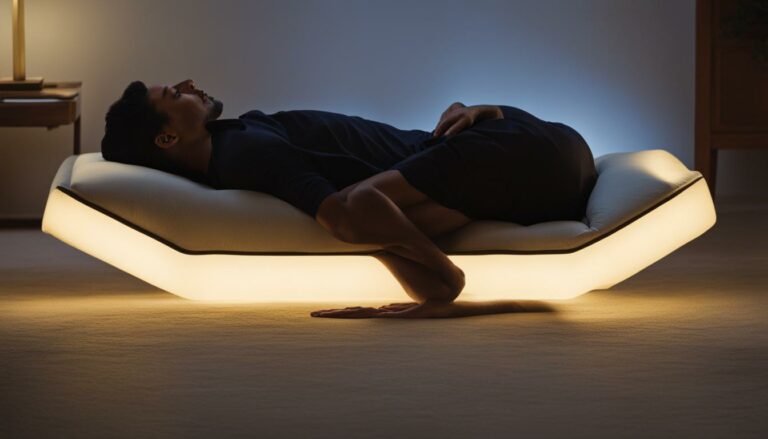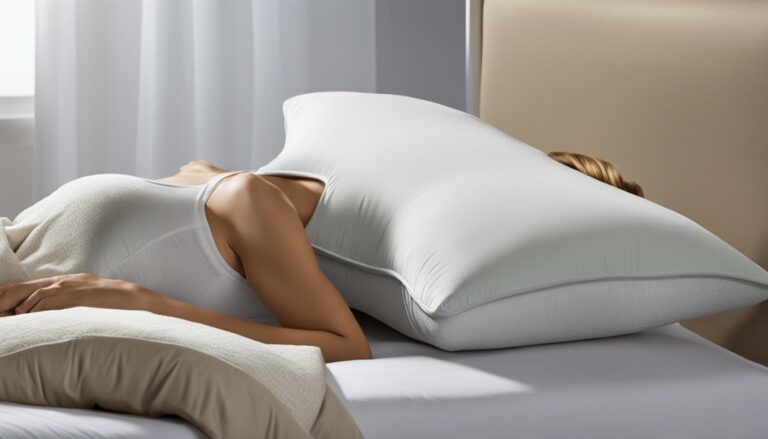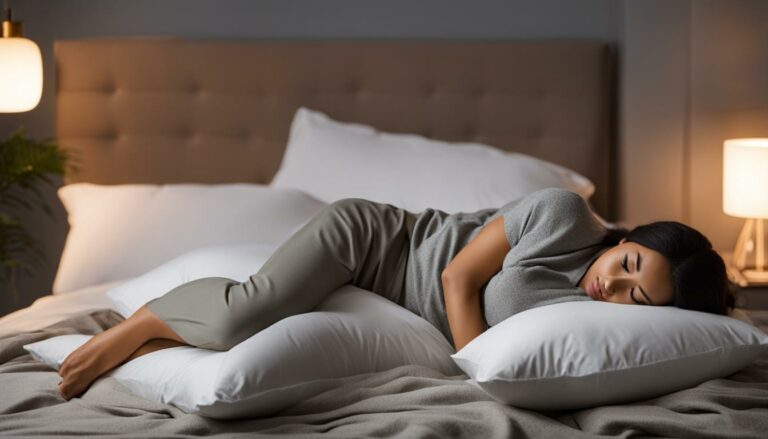Optimal Pillow Positioning for Neck Pain Relief
Eric Christie stands as a luminary in the bedding industry, with a career spanning nearly four decades since the early 1980s. His journey through the world of bedding has seen him wear many hats – a manufacturer, designer, and retailer, showcasing his versatility and expertise in Read more...
pillowsandbedsheets.com and its partners may earn a commission if you purchase a product through one of our links
Neck pain can disrupt your sleep and make everyday activities challenging. One crucial factor that can contribute to neck pain relief is the proper positioning of your pillow. Your pillow’s position and the way you sleep impact the alignment of your neck and spine, ultimately affecting your comfort and pain levels.
Key Takeaways:
- Positioning your pillow correctly can provide effective relief for neck pain.
- Optimal pillow positioning promotes proper alignment of the neck and spine.
- Your sleep position also plays a role in reducing neck pain.
- Back sleepers should use a pillow that supports the natural curvature of the neck.
- Side sleepers should use a taller pillow that keeps the spine aligned.
- Avoid sleeping on your stomach as it strains the neck and nerves.
- Experiment with different pillow sizes and positions to find the optimal support for your neck and spine.
Best Sleeping Positions for Back Pain
When it comes to back pain relief, your sleeping position plays a crucial role. The right sleeping position can help alleviate discomfort, promote proper spinal alignment, and prevent further strain on your back. Here, we’ll explore the best sleeping positions for back pain and provide tips to optimize your sleep position for maximum relief.
Sleeping on Your Back
Sleeping on your back is widely considered the best position for back pain relief. This sleeping position helps distribute your body weight evenly along the spine, reducing pressure and promoting proper alignment. To enhance the benefits, place a pillow under your knees. This supports the natural curve of your spine and further eases strain on your lower back.
Sleeping on Your Side
If you’re a side sleeper, you can still find relief from back pain by making a few adjustments. Start by placing a firm pillow between your knees. This helps maintain the alignment of your hips, pelvis, and spine, reducing strain on your lower back. Additionally, ensure your pillow adequately supports your head and neck to keep your spine properly aligned.
Avoid Sleeping on Your Stomach
Sleeping on your stomach is generally considered the worst position for back pain, as it puts excessive strain on the neck, spine, and lower back. If changing your preferred sleeping position is challenging, you can improve spinal alignment by placing a thin pillow under your hips and stomach. This helps reduce the stress on your lower back and promotes a more neutral position for your spine.
By adopting the proper sleeping positions for back pain, you can alleviate discomfort, support spinal alignment, and wake up feeling refreshed. Remember to experiment with different pillows and positions to find what works best for you. Additionally, maintaining a supportive mattress and creating a restful sleep environment can contribute to overall back pain relief.
Best Sleeping Positions for Neck Pain
When it comes to finding relief for neck pain, the right sleeping position can make all the difference. By choosing the best sleeping position for neck pain, you can help alleviate discomfort and promote better alignment of your neck and spine. Here are some sleeping positions that can provide neck pain relief:
Sleeping on your back
Sleeping on your back is one of the best positions for neck pain relief. It allows your spine to maintain its natural alignment and reduces strain on your neck. To optimize this sleeping position, use a pillow that supports the curvature of your neck and keeps your head cushioned without raising it too high. This helps maintain proper alignment and reduces the risk of waking up with a sore neck.
Sleeping on your side
Sleeping on your side is another excellent sleeping position for neck pain relief. When sleeping on your side, use a taller pillow that provides adequate support for your neck. This helps keep your spine properly aligned and ensures that your head and neck are well-supported throughout the night. By choosing the right pillow and sleeping on your side, you can minimize strain on your neck and wake up feeling refreshed.
Avoid sleeping on your stomach
While sleeping on your stomach may be comfortable for some, it can put strain on your neck and nerves, leading to neck pain. If possible, try to avoid this sleeping position. However, if it’s difficult for you to change positions, consider using a thin pillow or no pillow at all. This can help minimize strain on your neck and reduce the risk of waking up with discomfort.
“Finding the right sleeping position for neck pain can provide much-needed relief and improve the quality of your sleep.”
| Sleeping Position | Recommended Pillow |
|---|---|
| Back sleeping | A pillow that supports the curvature of the neck and keeps the head flatter |
| Side sleeping | A taller pillow that provides support for the neck |
| Stomach sleeping | A thin pillow or no pillow at all |
By following these sleeping position recommendations, you can optimize your sleep posture and reduce the likelihood of waking up with neck pain. Experiment with different pillow options and find the position that works best for you. Remember, a good night’s sleep is essential for overall well-being, and finding the right sleeping position for neck pain can provide much-needed relief and improve the quality of your sleep.
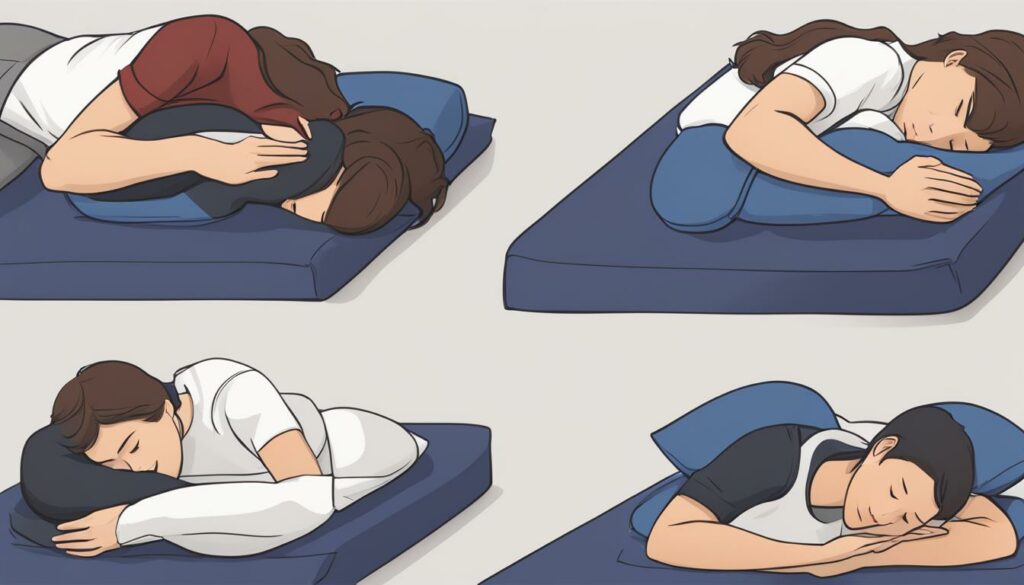
Sleeping Upright
When it comes to finding relief for both back and neck pain, sleeping upright or in a reclined position can be a game-changer. This sleep position is particularly beneficial for pregnant women experiencing back pain. By adjusting your sleeping position, you can alleviate discomfort and promote better spinal alignment.
To enhance your comfort and alignment while sleeping upright, consider using a horseshoe-shaped pillow. This type of pillow provides vital support to your neck and lower back, reducing strain on these areas. Additionally, lower back pillows can be used to provide extra support and ensure optimal alignment during sleep.
While sleeping upright may not be the most common position, it can be incredibly effective for back and neck pain relief. Try incorporating this sleep position into your routine and experience the difference it can make.
Tips for Sleeping Upright:
- Position a horseshoe-shaped pillow around your neck to provide support and maintain proper alignment.
- Place a lower back pillow to support the lumbar region and alleviate pressure on your spine.
- Adjust the recliner to a comfortable angle that promotes relaxation and reduces pain.
- Ensure your feet are supported to prevent strain on your lower back and hips.
With these tips and the right pillow support, you can sleep upright and wake up feeling refreshed and rejuvenated.
| Pros | Cons |
|---|---|
| Provides relief for back and neck pain | May not be comfortable for everyone |
| Reduces strain on the spine | Requires a suitable recliner or adjustable bed |
| Supports proper alignment of the neck and back | Can take time to adjust to this sleep position |
Discover the benefits of sleeping upright for back and neck pain relief. Improve your sleep quality and wake up feeling rejuvenated.
Pillow Positioning Tips for Neck Pain Relief
Proper pillow positioning is crucial for finding relief from neck pain. Your choice of pillows and their alignment with your body can significantly impact your sleep quality and alleviate discomfort in the neck. Whether you’re a side sleeper, back sleeper, or stomach sleeper, here are some tips to help you achieve the optimal pillow position for neck pain relief:
For Side Sleepers:
- Use larger pillows or stacks of pillows to maintain proper alignment of the neck with the spine.
For Back Sleepers:
- Place smaller pillows under the neck and back to ensure proper alignment.
For Stomach Sleepers:
- Place a pillow under the stomach or pelvis to support spinal alignment.
In addition to pillow positioning, consider using a feather pillow or memory foam pillow to provide optimal support for the neck. These pillow materials can conform to the contours of your neck, promoting proper alignment and reducing pressure points.
Remember, finding the right pillow position for neck pain relief may require some experimentation and adjustment. Pay attention to your body’s signals and make necessary changes to achieve the most comfortable and supportive pillow setup.
In the next section, we will explore further techniques for finding the optimal pillow position to alleviate neck pain.
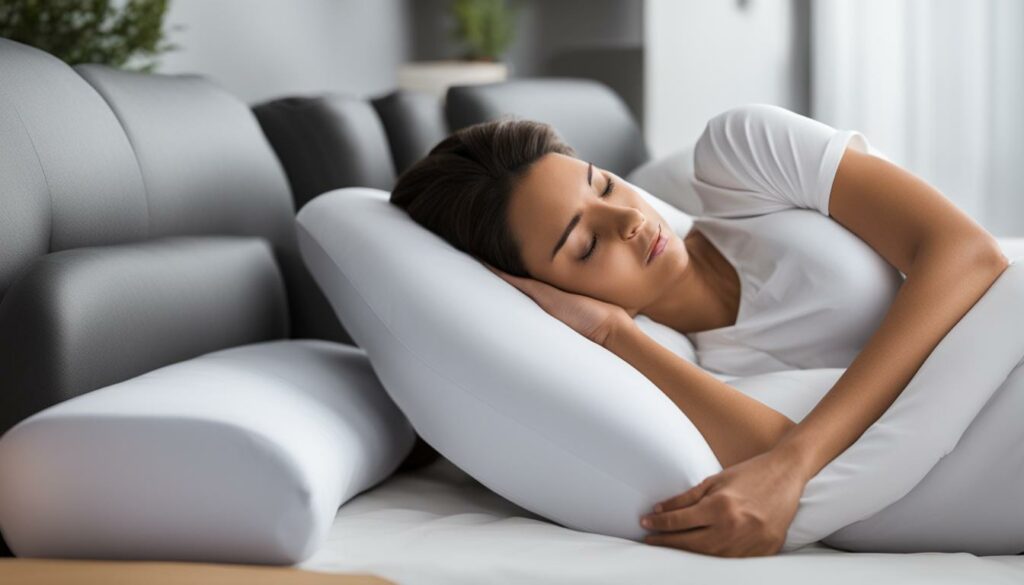
| Side Sleepers | Back Sleepers | Stomach Sleepers |
|---|---|---|
| Use larger pillows or stacks of pillows | Place smaller pillows under the neck and back | Place a pillow under the stomach or pelvis |
Finding the Right Pillow Position for Neck Pain
Finding the optimal pillow position for neck pain relief can be a process of trial and error. Each individual may have unique needs and preferences when it comes to pillow support. Whether you are a side sleeper, back sleeper, or stomach sleeper, adjusting your pillow position can make a significant difference in alleviating neck pain.
If you are a side sleeper, try experimenting with different pillow sizes and positions to find what works best for you. Some people find that using a firm pillow between their knees helps maintain proper alignment of the neck and spine. Others may benefit from a larger pillow that provides more support for the neck and shoulders.
Back sleepers can try placing pillows beneath the neck and back to achieve proper alignment. By using smaller pillows strategically positioned, you can provide the necessary support to maintain the natural curvature of the spine. This can help reduce strain on the neck and alleviate discomfort.
Stomach sleepers should focus on finding ways to transition to side or back sleeping positions to minimize strain on the neck. Sleeping on the stomach can lead to excessive rotation of the neck, causing pain and discomfort. Gradually adjusting your sleeping position and using a thinner pillow or no pillow at all can be beneficial for neck pain relief.
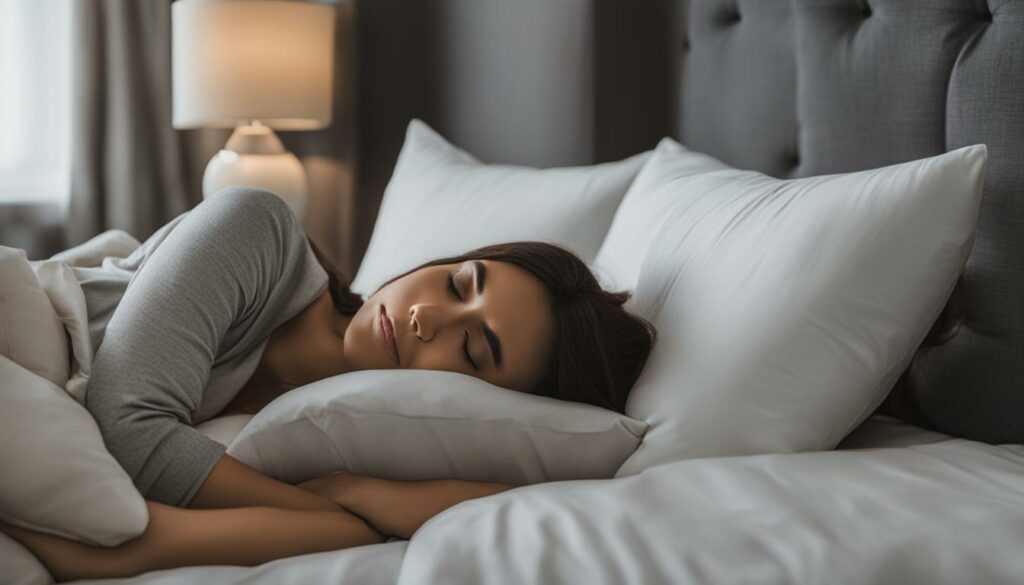
Remember, finding the right pillow position is a personal journey. It may take some time to find the perfect combination of pillow size, thickness, and position that brings you relief and comfort. Don’t be afraid to experiment and try different options until you find what works best for you.
By adjusting your pillow position to suit your specific needs, you can find relief from neck pain and promote better sleep quality. Prioritizing proper pillow alignment is an essential step in creating a restful and pain-free sleep environment.
Common Causes of Neck Pain During Sleep
Neck pain during sleep can be a frustrating experience that disrupts your rest and leaves you waking up with discomfort. Understanding the causes of neck pain during sleep is essential for finding effective solutions and achieving a better quality of rest. Here are some common reasons why you may experience neck pain while sleeping:
- Sleeping in an unsupported position: Sleeping in a position that does not adequately support your neck can lead to strain and discomfort. This can occur when using a pillow that is too high or too flat, resulting in improper spinal alignment.
- Poor posture during the day: Maintaining poor posture throughout the day can contribute to neck pain during sleep. Slouching or holding your head in an unnatural position can strain the muscles and ligaments in your neck, leading to pain and stiffness.
- Stress: We often carry tension in our neck and shoulders when we are stressed. This tension can linger when we go to bed, causing discomfort and pain during sleep.
- Physical activities that strain the neck muscles: Engaging in activities that place excessive strain on the neck, such as heavy lifting or repetitive movements, can lead to muscle fatigue and neck pain during sleep.
To effectively reduce neck pain during sleep, it is important to address these underlying causes. In addition to adjusting your pillow position, consider improving your posture during the day, managing stress levels, and incorporating exercises and stretches that strengthen the neck muscles.
“Proper support and a good sleep posture can make a significant difference in alleviating neck pain during sleep and promoting a more restful night.”
Consulting with a healthcare professional or a physical therapist can provide further guidance in managing and preventing neck pain during sleep. By identifying the root causes and making necessary adjustments, you can wake up feeling refreshed and free from neck pain.
| Possible Causes of Neck Pain During Sleep | Solutions |
|---|---|
| Sleeping in an unsupported position | Choose a pillow that provides proper neck support |
| Poor posture during the day | Practice good posture throughout the day and perform neck-strengthening exercises |
| Stress | Explore stress management techniques like meditation and relaxation exercises |
| Physical activities that strain the neck muscles | Avoid or modify activities that put excessive strain on the neck, and incorporate neck stretches |
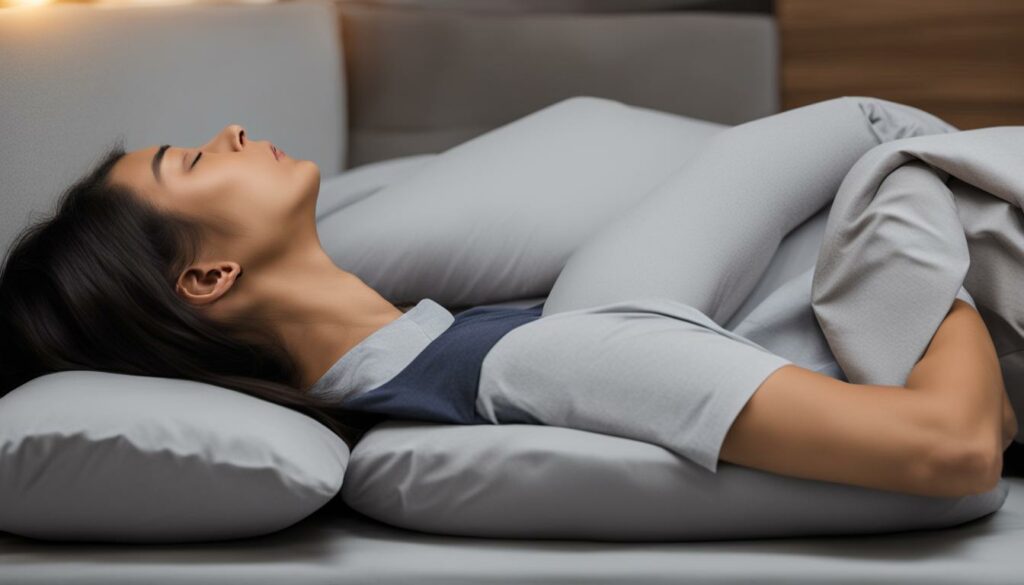
Creating a Restful Sleep Environment
Creating a restful sleep environment is essential for optimizing sleep space and promoting neck pain relief. By implementing a few simple tips, you can improve your sleep quality and wake up feeling refreshed. Here are some strategies to consider:
1. Invest in a Supportive Mattress and Pillow
A supportive mattress and pillow are crucial for maintaining proper spinal alignment and reducing pressure on the neck. Look for a mattress that provides adequate support for your body type and sleeping position. Similarly, choose a pillow that aligns with the natural curvature of your neck and provides optimal comfort.
2. Control the Room Temperature
Creating a comfortable sleep environment involves regulating the room temperature. The ideal temperature for most people falls between 60 to 67 degrees Fahrenheit (15 to 19 degrees Celsius). Experiment with different temperatures to find what works best for you and promotes restful sleep.
3. Minimize Light Exposure
Light exposure can disrupt your sleep-wake cycle and interfere with restful sleep. Before bedtime, dim the lights in your bedroom to signal to your body that it’s time to wind down. Consider using blackout curtains or an eye mask to block out external light sources.
4. Limit Screen Time Before Bed
The blue light emitted by electronic devices, such as smartphones, tablets, and computers, can negatively impact your sleep quality. To optimize your sleep space, establish a digital curfew by avoiding screens at least an hour before bed. Instead, engage in relaxing activities, such as reading a book or taking a warm bath.
5. Create a Calming Atmosphere
Transform your bedroom into a peaceful sanctuary by incorporating calming elements. Use soothing colors, such as blues or neutrals, on the walls and bedding. Consider adding relaxing scents with essential oils or a lavender-scented pillow spray.
6. Establish a Bedtime Routine
A consistent bedtime routine can signal to your body that it’s time to unwind and prepare for sleep. Engage in relaxing activities, such as stretching or practicing deep breathing exercises, to promote relaxation. Reading a book or listening to soft music can also help ease your mind and transition into a restful state.
By implementing these tips, you can optimize your sleep space and create an environment that supports restful sleep and neck pain relief.
Additional Tips for Neck Pain Relief
In addition to proper pillow positioning and creating a conducive sleep environment, there are several other strategies you can implement to alleviate neck pain. By making lifestyle changes and incorporating targeted exercises into your routine, you can experience significant relief. Here are some additional tips to help you find relief from neck pain:
1. Stress Management Techniques:
Stress can manifest as tension in the neck muscles, exacerbating neck pain. Incorporate stress management techniques such as meditation, deep breathing exercises, or yoga into your daily routine. These practices can help reduce muscle tension and promote overall relaxation, leading to neck pain relief.
2. Stretching Exercises:
Gentle stretching exercises can help improve flexibility and reduce muscle stiffness in the neck. Incorporate neck stretches into your daily routine to relieve tension and promote relaxation. Examples of neck stretches include neck tilts, neck rotations, and side-to-side neck stretches.
3. Proper Daytime Posture:
Adopting and maintaining good posture throughout the day can have a significant impact on neck pain. Be mindful of your posture while sitting, standing, and engaging in activities. Avoid slouching or hunching over, as this can strain the neck muscles. Use ergonomic chairs and support devices when necessary to maintain a neutral neck position.
4. Over-the-Counter Pain Medications:
If you experience mild to moderate neck pain, over-the-counter pain medications such as ibuprofen or acetaminophen can provide temporary relief. However, it is important to use these medications cautiously and follow the dosage instructions provided.
5. Heat or Cold Therapy:
Applying heat or cold to the affected area can help alleviate neck pain. Apply a heating pad or warm towel to the neck for soothing warmth, or use a cold pack or ice wrapped in a cloth for numbing cold. Experiment to determine which therapy works best for you.
By incorporating these additional tips into your routine, you can complement pillow positioning techniques and create a comprehensive approach to neck pain relief. Remember to consult with a healthcare professional if your neck pain persists or worsens, as they can provide personalized guidance and treatment options.
Seeking Professional Help for Neck Pain
If you have been experiencing persistent or worsening neck pain, despite trying self-care measures, it may be time to seek professional help. Consulting a healthcare provider can provide valuable insights into the underlying cause of your neck pain and guide you towards proper treatment options.
A healthcare professional will conduct a thorough evaluation to determine the root cause of your neck pain. They may recommend diagnostic tests, such as imaging scans, to get a clearer understanding of your condition. Based on their assessment, they will develop a personalized treatment plan that suits your specific needs.
In addition to prescribing medications for pain relief, your healthcare provider may suggest physical therapy or other forms of rehabilitation. These interventions aim to improve your neck’s range of motion, strengthen supporting muscles, and alleviate pain in the long term. They may also provide guidance on how to adjust your posture and recommend specialized pillows or neck supports to promote proper alignment and reduce discomfort during sleep.
If your neck pain is persistent, interfering with your daily activities, or combining with other symptoms, it is crucial to consult a healthcare professional. They have the expertise to identify and address any underlying conditions contributing to your neck pain. Don’t hesitate to reach out and get the help you need for effective neck pain relief.
FAQ
How should I position my pillow for neck pain relief?
When sleeping on your back, use a pillow that supports the curvature of your neck and keep the pillow flatter to cushion your head. If sleeping on your side, use a taller pillow to support your neck and keep your spine aligned. Avoid sleeping on your stomach as it can put strain on the neck and nerves, but if necessary, use a thin pillow or no pillow at all.
What are the best sleeping positions for back pain relief?
The best sleeping position for alleviating back pain is sleeping on your back. This position distributes the weight along the spine, promoting proper alignment. Placing a pillow under the knees helps maintain the natural curve of the spine. For side sleepers, placing a firm pillow between the knees helps maintain the alignment of the hips, pelvis, and spine. Lying on your stomach is considered the worst sleeping position for back pain, but if it’s challenging to change positions, placing a thin pillow under the hips and stomach can improve spinal alignment.
What are the best sleeping positions for neck pain relief?
The best sleeping positions for neck pain are sleeping on your back or on your side. When sleeping on your back, use a pillow that supports the curvature of your neck and keep the pillow flatter to cushion your head. If sleeping on your side, use a taller pillow to support your neck and keep your spine aligned. Avoid sleeping on your stomach as it can put strain on the neck and nerves, but if necessary, use a thin pillow or no pillow at all.
How can sleeping upright help with back and neck pain relief?
Sleeping in an upright position or in a recliner can provide relief for both back and neck pain. This is especially common among pregnant women with back pain. Using a horseshoe-shaped pillow to support the neck and lower back, as well as using lower back pillows, can enhance comfort and alignment.
What are some tips for proper pillow positioning for neck pain relief?
For side sleepers, using larger pillows or stacks of pillows can help maintain proper alignment of the neck with the spine. Back sleepers can benefit from smaller pillows placed under the neck and back to ensure proper alignment. Stomach sleepers should place a pillow under the stomach or pelvis to support spinal alignment. Additionally, using a feather pillow or memory foam pillow can provide optimal support for the neck.
How can I find the right pillow position for neck pain?
Finding the right pillow position for neck pain may require some trial and error. Side sleepers can experiment with different pillow sizes and positions to find the optimal support for their neck and spine. Back sleepers can try placing pillows beneath the neck and back to achieve proper alignment. Stomach sleepers should focus on finding ways to transition to side or back sleeping positions to reduce strain on the neck.
What are the common causes of neck pain during sleep?
Neck pain during sleep can be caused by several factors, including sleeping in an unsupported position, poor posture during the day, stress, and physical activities that strain the neck muscles. It is important to address these potential causes in addition to adjusting pillow position to achieve better sleep and alleviate neck pain.
How can I create a restful sleep environment to alleviate neck pain?
Creating a restful sleep environment can contribute to neck pain relief. It is recommended to have a supportive mattress and appropriate pillows. Room temperature, light exposure, and screen time before bed should also be considered. Optimizing the sleep space and ensuring comfort can contribute to better sleep quality and reduce neck pain.
Are there any additional tips for neck pain relief?
In addition to pillow positioning and sleep environment, there are other factors that can help alleviate neck pain. Stress management techniques, such as meditation and breathing exercises, can reduce tension in the neck. Stretching exercises and proper daytime posture can also contribute to neck pain relief. Over-the-counter pain medications and heat or cold therapy may provide temporary relief but should be used cautiously.
When should I seek professional help for neck pain?
If neck pain persists or worsens despite self-care measures, it is important to seek professional help. A healthcare provider can evaluate the underlying cause of neck pain and provide appropriate treatment options. They may also recommend physical therapy, specialized pillows, or other interventions for long-term neck pain relief.
Eric Christie stands as a luminary in the bedding industry, with a career spanning nearly four decades since the early 1980s. His journey through the world of bedding has seen him wear many hats – a manufacturer, designer, and retailer, showcasing his versatility and expertise in Read more...



